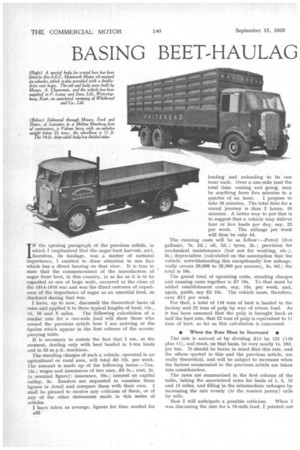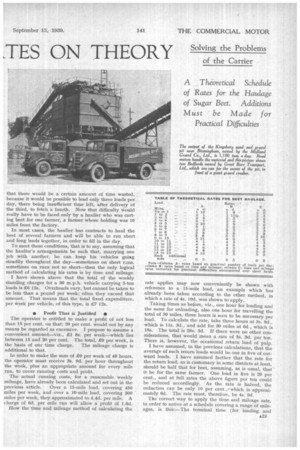BASING BEET-HAULAG TES ON THEORY
Page 24

Page 25

Page 26

If you've noticed an error in this article please click here to report it so we can fix it.
IN. the opening paragraph of the previous article, in which I emphasized that the sugar-beet harvest, and, therefore, its haulage, was . a Matter of national importance, I omitted to draw attention to one fact which has a direct bearing on that view. It is true to state that the commencement of the manufacture of sugar from beet, in this country, in so far as it is to be regarded as one of large scale, occurred at the close of the 1914-1918 war and was the direct outcome of experience of the importance of sugar as an essential food, as disclosed during that war.
I have, up to now, discussed the theoretical basis of rates and applied it to three typical lengths of haul, viz.,
15, 10 and 5 miles. The following calculation of a similar rate for a one-mile lead will show those who missed the previous article how I am arriving at the figures which appear in the first column of the accom
panying table. , It is necessary to restate the fact that I am, at the moment, dealing only with beet hauled in 5-ton loads and in 33 m.p.h. machines.
The standing charges of such a vehicle, operated in an agricultural or rural area, will total 26 12s. per week. The amount is made up of the following items:—Tax, 12s.; wages and insurances of two men, 25 Sc.; rent, 2s. (a nominal figure) ; insurance, 10s.; interest on capital outlay, 3s. Readers are requested to examine these figures in detail and compare them with their own. I shall be pleased to receive any criticism of them, or of any of the other statements made in this series of articles.
I have taken as average, figures for time needed for A22
loading and unloading to be one hour each. Over a one-mile lead the total time, coming and going, may be anything from five minutes to a quarter of an hour. I propose to take 10 minutes_ The total time for a round journey is thus 2 hours, 10 minutes. A better way to put that is to suggest that a vehicle may deliver four or five loads per day, say, 22 per week. The mileage per week will thus be only 44.
The running costs will be as follow :—Petrol (five gallons), 7s. id.; oil, 5d.; tyres, 2s. ; provision for mechanical maintenance (but not for washing, etc.), 3s.; depreciation (calculated on the assumption that the vehicle, notwithstanding this exceptionally low mileage, really covers 20,000 to 25,000 per annum), 5s. 6d.; the total is 18s.
The grand total of operating costs, standing charges and running costs together is 27 10s. To that must be added establishment costs, say, 15s. per week, and, again, profit, say 22 15s. The vehicle must, therefore, earn El 1 per week.
For that, a total of 110 tons of beet is hauled to the factory and 22 tons of pulp by way of return load. As it has been assumed that the pulp is brought back at half the beet rate, that 22 tons of pulp is equivalent to 11 tons of beet, so far as this calculation is concerned.
• When the Rate Must be Increased • The rate is arrived at by dividing 211 by 121 (110 plus 11), and must, on that basis, be very nearly is 10d. per ton. It should be borne in mind that this rate, and the others quoted in this and the previous article, are really theoretical, and will be subject to increases when the factors enumerated in the previous article are taken into consideration.
The rates are summarized in the first column of the table, taking the ascertained rates for leads of 1, 5, 10 and 15 miles, and filling in the intermediate mileages by increasing the rate evenly (to the nearest penny) mile by mile.
Now I will anticipate a possible criticism. When was discussing the rate for a 10-mile dead, I pointed out that there would be a certain amount of time wasted, because it would be possible to lead only three loads per day, there being insufficient time left, after delivery of the third, to fetch a fourth. Now that difficulty would really have to be faced only by a haulier who was carting beet for one fanner, a farmer whose holding was 10 miles from the factory.
In most cases, the haulier has contracts to haul the beet of several farmers and will be able to run short and long leads together, in order to fill in the day.
To meet those conditions, that is to say, assuming that the haulier's arrangements be such that, marrying one job with another, he can keep his vehicles goimg steadily throughout the day—sometimes on short runs, sometimes on runs not so short—then the only logical method of calculating his rates is by time and mileage.
I have shown above that the total of the weekly standing charges for a 30 m.p.h. vehicle carrying 5-ton loads is 26 12s. Overheads vary, but cannot be taken to be less than a pound per week; often they exceed that amount. That means that the total fixed expenditure, per week per vehicle, of this type, is 27 12s.
• Profit That is Justified • The operator is entitled to make a profit of not less than 15 per cent, on that; 20 per cent. would not by any means be regarded as excessive. I propose to assume a convenient amount—viz., 21 8s. per week—which lies between 15 and 20 per cent. The total, 29 per week, is the basis of our time charge. The mileage charge is additional to that.
In order to make the sum of 29 per week of 48 hours, the operator must receive 3s. 9d. per hour throughout the week, plus an appropriate amount for every mile run, to cover running costs and profit.
The actual running costs, for a reasonable weekly mileage, have already been calculated and set out in the previous article. Over a 15-mile lead, covering 450 miles per week, and over a 10-mile lead, covering 300 " miles per week, they approximated to 4.4d. per mile. A charge of 6d. per mile run will allow a profit of 1.6d.
How the time and mileage method of calculating the rate applies may now conveniently be shown with reference to a 15:mile lead, an example which has already been taken according to the other method, in which a rate of 4s. led, was shown to apply.
Taking times as before, viz., one hour for loading and the same for unloading, also one hour for travelling the total of 30 .miles, three hours is seen to be necessary per load. To calculate the rate, take three hours at 3s. 9d., which is us. 3c1., and add for 30 miles at 6d., which is 15s. The total is 26s. 3d. If there were no other considerations, that would mean a rate of 5s. 8d. per ton. There is, however, the occasional return load of pulp.
I have assumed, in the previous calculations, that the average of such return loads would be one in five of outward loads. 1 have assumed further that the rate for the return load, as is customary in some districts at least, should be half that for beet, assuming, as is usual, that 'S it be for the same farmer. One load in five is 20 per cent., and at full rates the above figure per ton could be reduced accordingly. As the rate is halved, the reduction can be only 10 per cent,which is approximately 6d. The rate must, therefore, be 4s. 9d.
The correct way to apply the time and mileage rate, in order to arrive at a schedule covering a range of mileages, is this:—The terminal time (for loading and a28 unloading and normal periods of waiting) is two hours. That, at Ss. 9d. per hour, is 7s. 6d.
For the first three miles take 5 minutes per mile run, which is 10 minutes per mile lead (2 miles have to be covered per mile lead). The charge for time per mile lead, up to 3 miles, is thus 7id. There is also the mileage charge, and that, at 6d. per mile run, is is. For a 1-mile lead, therefore, the total charge must be 7s. 6d., plus Is. 7id., i.e., 9s. lid. That is is. 10d. per ton, less 10 per cent., or is. 8d.
Each additional mile adds is. 70., less 10 per cent., to the total, i.e., Is. 5id., or Sid. per ton.
Beyond three miles, a better speed can be made, and 3d. per ton per mile additional is sufficient. Rates on that basis are given in the second column of the table.
I must mention one more thing and then I shall have done with this theoretical calculation. Experience has shown that there is always a greater risk of calculations being upset over short leads than over long ones. This factor cannot be set out in precise terms, and the only practical way to allow for it is by adding a percentage to the calculated rates for the short hauls. One accepted procedure is to add 20 per cent, to the rate for a mile lead and reduce that percentage mile by mile until 10 miles is reached. That I have done, the result being the figures in the third column of the table.,
Once more I emphasize that the rates in the table are not those which I recommend for adoption. Additions must be made to meet practical. difficulties. With those I shall deal in the next article. S.T.R.




























































